by Stephanie Vierra, Assoc. AIA, LEED AP BD+C — Vierra Design & Education Services, LLC
The WBDG was created and continues to evolve as the only online portal providing built environment practitioners access to relevant building-related guidance, up-to-date federal criteria, new technology information, and workforce development training from a 'whole building' perspective. For over two decades, the National Institute of Building Sciences has offered this valuable resource to the building community through funding and advisory support from the Department of Defense (represented by the NAVFAC Engineering Innovation and Criteria Office, U.S. Army Corps of Engineers and Air Force Civil Engineer Center), the Department of Veterans Affairs, the Department of Energy, the U.S. General Services Administration (GSA), the Department of State Bureau of Overseas Buildings Operations (OBO), and the Department of Homeland Security. The WBDG is unique as it represents a collaborative effort among not only government agency subject matter experts but also those from private sector companies, non-profit organizations, and educational institutions all contributing their knowledge and experience to better serve the building community.
The Role of Buildings and the Case for Whole Building Design
Buildings are deceptively complex. At their best, they connect us with the past and represent the greatest legacy for the future. They provide shelter, encourage productivity, embody our culture, and certainly play an important part in life on the planet. In fact, the role of buildings is constantly changing. Buildings today are life support systems, communication and data terminals, centers of education, justice, community, and so much more. They are incredibly expensive to build and maintain and must constantly be adjusted to function effectively over their life cycle. The economics of building are as complex as its design.
Data from the U.S. Energy Information Administration illustrates that buildings are responsible for 40% of greenhouse gas emissions annually. Of those total emissions, building operations are responsible for 27% annually, while building and infrastructure materials and construction (typically referred to as embodied carbon) are responsible for an additional 13% annually. A few of the many building materials are responsible for 23% of total global emissions. Seventy-six percent of all electricity generated by U.S. power plants goes to supply the building sector1 and buildings often contribute to health problems such as asthma and allergies due to poor indoor environmental quality. Safety is also paramount in buildings with security-related expenditures, one of the fastest rising expenses. There is a great opportunity to reduce these impacts and costs through whole building design.
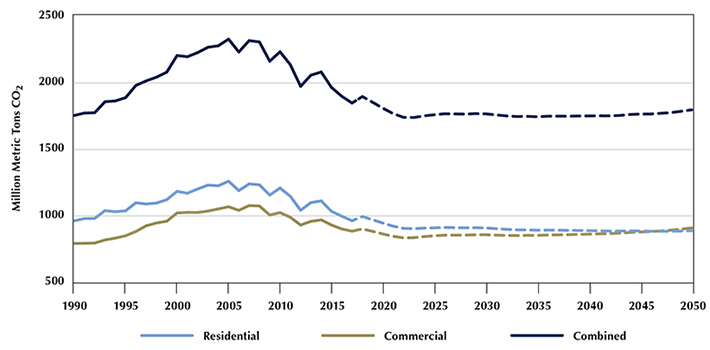
Building-related CO2 Emissions, 1990-2050.
Source: U.S. Energy Information Administration
The federal government responded to these challenges by putting into place Executive Orders and Mandates. High-performance buildings were defined in the Energy Policy Act of 2005 (Public Law 109-058) as: "buildings that integrate and optimize all major high-performance building attributes, including energy efficiency, durability, life-cycle performance, and occupant productivity".
The Energy Independence and Security Act (EISA) of 2007 further established a new and aggressive plan for achieving energy independence in our nation's building stock by the year 2030. The Act requires that federal buildings (new and renovations) achieve fossil fuel-generated energy consumption reductions on the order of 55 percent in the year 2010 to 100 percent by 2030. The Act also requires that sustainable design principles be applied to siting, design, and construction. It is of note that the Act defines High-Performance Buildings as the integration and optimization on a life-cycle basis all major high-performance attributes, including energy conservation, environment, safety, security, durability, accessibility, cost-benefit, productivity, sustainability, functionality, and operational considerations. These issues are synonymous with whole building design.
Private sector programs, including LEED®, Green Globes, the Living Building Challenge, and many other rating systems, define standards and measures for sustainable buildings and entire neighborhoods. Also, the Building Security Council's (BSC) Building Rating System and certification for professionals was created to help measure and benchmark security in buildings. The private sector and industry also responded by creating more products and systems that have multiple benefits. The knowledge, materials, and systems exist and are readily available to make a positive impact on the environment and on the quality of life of building occupants.
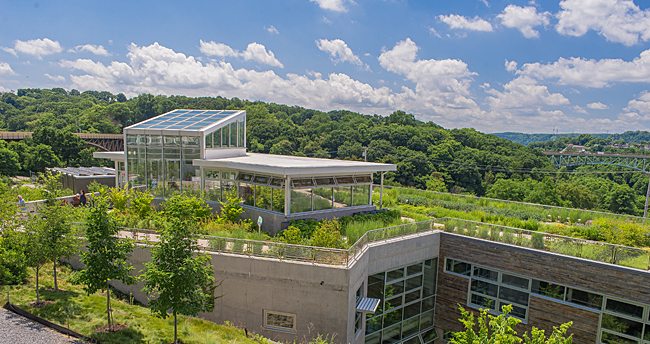
Through an effective integrated design process, the Center for Sustainable Landscapes achieved LEED Platinum, Living Building Challenge Certification, Sustainable SITES 4 star Certification, and WELL Building Platinum Certification.
Photo Credit: Paul g. Wiegman
Whole Building Design encompasses all of these issues and programs and is an essential way of approaching building projects. Understanding Whole Building Design concepts will enable you to think and practice in an integrated fashion to meet the demands of today's as well as tomorrow's high-performance building projects.
The Philosophy and Components of Whole Building Design
The concept of "wholes" is not new. Jan Christian Smuts, a South African Prime Minister and philosopher, coined the term "holism". He believed that there are no individual parts in nature, only patterns and arrangements that contribute to the whole. These ideas were explored in Holism and Evolution, the book he authored in 1926 that is still relevant and sought after today. Smuts considered this the beginning of a journey of seeing the world through a new lense that supports the exploration of different possibilities.

Buckminster Fuller, the pioneering global thinker and innovator, said in 1969 while working on the space program: "Synergy is the only word in our language that means behavior of whole systems, unpredicted by the separately observed behaviors of the system's parts or any subassembly of the system's parts."
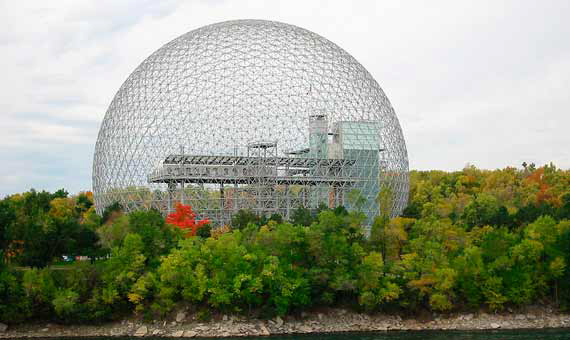
Buckminster Fuller made the geodesic dome famous including the Montreal Biosphere designed for Expo '67.
Photo Credit: Cédric Thevenet
Whole Building Design draws upon these concepts of synergies and interconnectedness and consists of two components:
- an integrated design approach and
- an integrated team process.
The "integrated design approach" asks all the members of the building stakeholder community, the technical planning, design, and construction team to look at the project objectives, building materials, systems, and assemblies from many different perspectives. This approach is a deviation from the typical planning and design process of relying on the expertise of specialists who work in their respective specialties somewhat isolated from each other and often in a linear manner.
Whole Building design in practice requires an "integrated team process" in which the design team and all affected stakeholders work together throughout the project phases and to evaluate the design for cost, quality-of-life, future flexibility, efficiency; overall environmental impact; productivity, creativity; and how the occupants will be enlivened. The 'Whole Building Design' process draws from the knowledge pool of all the stakeholders across the life cycle of the project, from defining the need for a building, through planning, design, construction, building occupancy, and operations.
These two components are discussed in more detail below.
The Integrated Design Approach

Each design objective may be significantly important or unique in any project, yet a truly successful one is where project goals are identified early on and held in proper balance during the design process. Their interrelationships and interdependencies with all building systems are also understood, evaluated, appropriately applied, and coordinated concurrently from the planning and programming phase all the way through operations and maintenance. A high-performance building cannot be achieved unless the integrated design approach is employed.
Design Objectives of Whole Building Design
In buildings, to achieve a truly successful holistic project, these design objectives must be considered in concert and in balance with each other:
-
Accessible: Addresses building elements, heights and clearances implemented to address the specific needs of disabled people.
-
Aesthetics: Concerns the physical appearance and image of building elements and spaces as well as the integrated design process.
-
Cost-Effective: Pertains to selecting building elements on the basis of life-cycle costs (weighing options during concepts, design development, and value engineering) as well as basic cost estimating and budget control.
-
Functional/Operational: Relates to functional programming—spatial needs and requirements, system performance as well as durability and efficient maintenance of building elements.
-
Historic Preservation: Considers specific actions within a historic district or affecting a historic building whereby building elements and strategies are classifiable into one of the four approaches: preservation, rehabilitation, restoration, or reconstruction. It is also a priority to identify and consider the use of existing buildings before building new ones.
-
Productive: Refers to occupants' well-being—physical and psychological comfort—including building elements such as air distribution, lighting, workspaces, systems, and technology.
-
Secure/Safe: Pertains to the physical protection of occupants and assets from man-made and natural hazards.
-
Sustainable: Resolves environmental performance and impacts of building elements and strategies.
Whole Building Design provides the strategies to achieve a true high-performance building: one that is cost-effective, safe, secure, accessible, flexible, aesthetic, productive, and sustainable over its entire life cycle.
Through a systematic analysis of these interdependencies, and leveraging whole building design strategies to achieve multiple benefits and synergies, a much more efficient and cost-effective building can be produced. For example, the choice of a mechanical system might impact the quality of the air in the building, the ease of maintenance, global climate change, operating costs, fuel choice, and whether the windows of a building are operable. In turn, the size of the mechanical system will depend on factors such as, the type of lighting and controls used, how much natural daylight is brought in, how the space is organized, the facility's operating hours, and the local microclimate. At the same time, these same materials and systems choices may have an impact on the aesthetics, accessibility, and security of the project. A successful Whole Building Design is a solution that is greater than the sum of its parts.
The International terminal building in Istanbul's Ataturk Airport includes laminated glass for safety and security while still allowing ample daylight into the terminal.
Photo Courtesy of DuPont Laminated Technologies
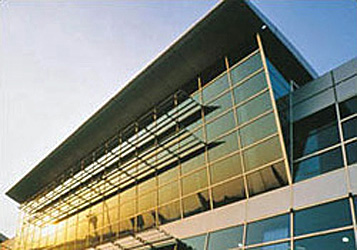
The Integrated Team Process
To create a successful high-performance building, an interactive approach to the design process is also required. It means all the stakeholders—everyone involved in the planning, design, use, construction, operation, and maintenance of the facility—must fully understand the issues and concerns of all the other parties and interact closely throughout all phases of the project.
Who needs to be at the table at the outset of a project to ensure an integrated team process? Each project is unique and will require the team and expertise to be matched to the long-term goals of the project. The team may include but is not limited to: the Architect, Landscape Architect, Owner, Client, Tenants, Engineers, Programmers, Interior Designer, Contractor, Specialists (Security, Telecom, Acoustics, LEED AP), Community Members or Other Stakeholders, Operations and Maintenance Personnel, and others such as a Real Estate Buyer. (See Engage the Integrated Design Process.)

An integrated, interdisciplinary team is an important component of the whole building design process.
Photo Credit: usability.gov
A design charrette—a focused and collaborative brainstorming session held at the beginning of a project—encourages an exchange of ideas and information and allows truly integrated design solutions to take form. Team members—all the stakeholders—are encouraged to cross fertilize and address problems beyond their field of expertise. The charrette is particularly helpful in complex situations where many people represent the interests of the client and conflicting needs and constituencies. Participants are educated about the issues and resolution enables them to "buy into" the schematic solutions. A final solution isn't necessarily produced, but important, often interdependent, issues are explored. (See Planning and Conducting Integrated Design Charrettes.)
It is not enough to design the project in a holistic manner. It is also important to determine and measure the effectiveness and outcome of the integrated design solution over the defined life cycle. Conducting a Facility Performance Evaluation will help ensure that the high-performance goals have been met and will continue to be met over the life cycle of the project. Consider retro-commissioning to ensure that the building will continue to optimally perform through continual adjustments. (See Building Commissioning and Commissioning Document Compliance and Acceptance.)
Emerging Issues
As the world of buildings continues to change and grow in complexity, additional programs and information will have an impact on the entire design, planning, and construction community. Among them is Building Information Modeling (BIM) software that is a continued trend in computer-aided design. Many buildings have been built directly from the electronic models that BIM creates, and some architects no longer create drawings but instead "build buildings inside their computers." BIM changes the role of drawings for the construction process, improves architectural productivity, and makes it easier to consider and evaluate design alternatives. BIM also aids in the process of integrating the various design teams' work, furthering encouraging and demanding an integrated team process. BIM supports continuous monitoring and management to operate and optimize a project throughout its life cycle.
The use of Building Automation Systems (BAS) supports the efficient and effective access, control, monitoring, and management of connected building systems in an integrated manner. This can include the HVAC, lighting, power, access control systems, and more. The use of BAS allows for greater visibility and control over these building elements, saves time and resources, and offers greater comfort and control over spaces.
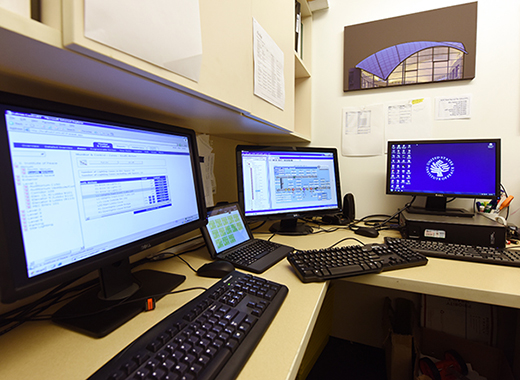
BAS in use at the U.S. Institute of Peace (USIP).
Photo Credit: USIP
In Summary
High-Performance Buildings are energy efficient, have limited environmental impact, operate with the lowest possible life-cycle costs, and have a positive effect on building occupants. There are a number of additional ways and tools to achieve high-performance buildings, such as through the implementation of a life-cycle cost analysis, integrated design processes, integrated energy solutions for the building envelope, and building commissioning.
Additional Resources
- Integration at Its Finest: Success in High-Performance Building Design and Project Delivery in the Federal Sector by Renée Cheng, AIA, Professor, School of Architecture, University of Minnesota. Sponsored by the Office of Federal High-Performance Green Buildings, U.S. General Services Administration, 2014.
- PBS P100 Facilities Standards For The Public Buildings Service by the U.S. General Services Administration, 2021.
1. [Source: www.architecture2030.org]








